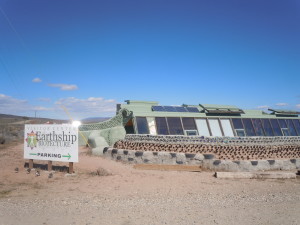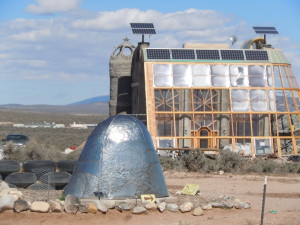Earthship: Redefining Sustainable Housing
Earthship Biotecture World Headquarters, just outside Taos, New Mexico, is a deep ecology subdivision of some 70 homes, expected to grow eventually to about 130. It sits on 650 acres, of which 347 acres are parkland, owned in common by the residents.  The houses look like a mating between the Taos Pueblo adobe of 1000 years ago and Starship Enterprise. Visitors can go through a self-guided tour with explanatory video and slideshow and learn how the homes—off-grid not just for electricity but also for water and sewer—are constructed to use very little electricity, water, or heating/cooling energy. I asked Ashton Wolfe, one of the media liaisons, what was different about Earthships compared to other passive solar earth-sheltered homes. She explained that:
The houses look like a mating between the Taos Pueblo adobe of 1000 years ago and Starship Enterprise. Visitors can go through a self-guided tour with explanatory video and slideshow and learn how the homes—off-grid not just for electricity but also for water and sewer—are constructed to use very little electricity, water, or heating/cooling energy. I asked Ashton Wolfe, one of the media liaisons, what was different about Earthships compared to other passive solar earth-sheltered homes. She explained that:
- Earthships are fairly self-contained: they generate their own electricity and all or most of their own water (the threshold is eight inches of rain a year, so in a dry, desert climate like Taos, extra water is sometimes needed). Passive solar design and thick earthen and rubber tire walls eliminate the need for any fossil-fuel-based heating or cooling system. Attached greenhouses not only provide growing space for food, but also create an essential climate barrier between extreme outside temperatures (ranging from -30° to over 100°F in Taos, assisting the homes in maintaining temperatures ranging from 65 to 75° all year long, without any need for outside power sources.
- The key structural innovation is old tires packed with soil.
- The buildings contain a large percentage of recycled materials, and thus are somewhat different from unit to unit. Many of these are not traditional building materials, but things like old cans and bottles, so Earthships also reduce landfill volume.
- Water is used four times, filtered through a system of restorer cells that capture and purify wastewater. It starts with the highest uses: drinking and washing, then domestic uses, flushing toilets and finally, exterior landscaping: watering nonfood plants.
- Earthship homes, which have been built in every state and in some 18 countries, lend themselves well to building on undeveloped lots. Much of the cost of a “normal” home is in the infrastructure: connecting water, sewer, and electricity, for instance. While Earthships’ construction cost is higher, at about $200-$250 per square foot in a place like Taos, the lack of infrastructure costs result in a house that is pretty much comparably priced with a conventional home—and of course, far cheaper to operate over the lifespan of the house.
- The concept was developed by Michael Reynolds in the years after his graduation from architecture school in 1969. By 1975, he was using the filled-tire construction method, and the first Earthship incorporating self-sufficiency in water, power, heating, and cooling was constructed back in 1988.

The Earthship community has a very informative website at Earthship.com. It looks like there’s very little there when you srrive at the website, but scroll down or click through to the blog and you’ll see there’s actually quite a bit.

